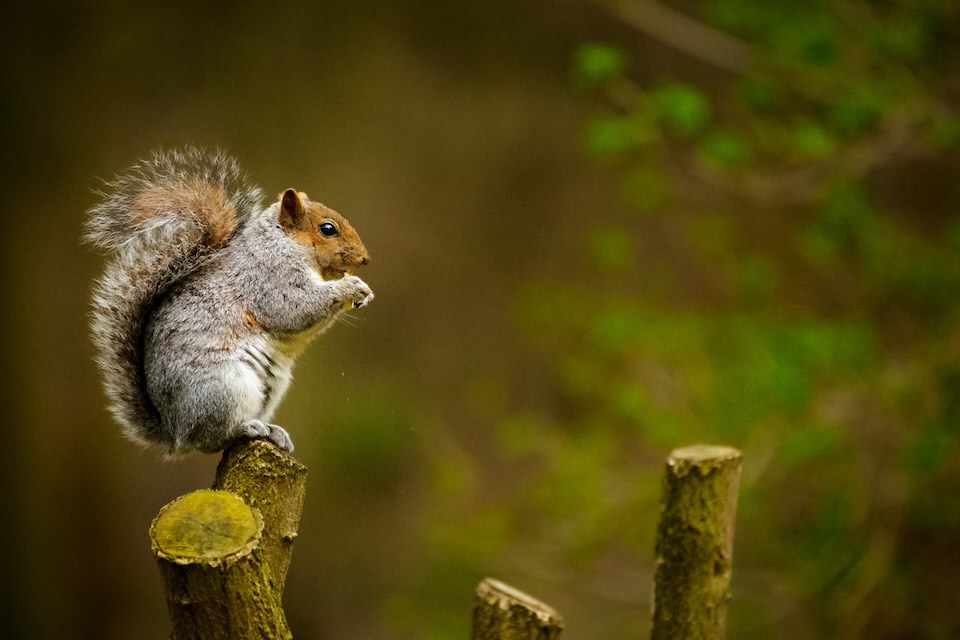Squirrel Species Identification Guide for Ontarians

Ontario’s backyards, forests, and urban parks are full of squirrels—but not all of them behave the same way. Of the 23 species of native squirrels found in Canada, nine live in Ontario. That variety often leads to confusion, especially when squirrels turn from cute backyard wildlife into persistent problems in your attic, soffits, or garden.
Chewed wiring, torn insulation, attic infestations, and garden destruction are all too common once squirrels decide to make your property their own. This guide isn’t just about identifying squirrels—it’s about helping you recognize the early warning signs, understand squirrel behaviour, and know when it’s time to take action.
Common Squirrel Types in Ontario
Squirrel species fall into one of two broad categories: tree squirrels and ground squirrels. Tree squirrels are the climbers—often seen leaping between branches, climbing trees, nesting in tree cavities or attics, and occasionally stealing snacks from bird feeders. Ground squirrels live and burrow in the soil.
Ontario’s tree squirrels include the eastern gray squirrel, red squirrel, fox squirrel, southern flying squirrel, and northern flying squirrel. Ground squirrels, such as the thirteen lined ground squirrel, are less commonly seen in urban areas but still present in certain parts of the province. Many species thrive in green, suburban settings where natural food and shelter are plentiful.
Eastern Gray Squirrel (Sciurus carolinensis)
The eastern gray squirrel is by far the most familiar species in Ontario, found in virtually every town and city. Despite the name, they come in both gray and black colour variants—black squirrels are simply a darker morph. Some may also display brown fur, depending on genetics.
Known for their boldness around humans and interest in bird feeders, these squirrels are excellent climbers and often gain access to attics and rooflines. Their presence is common, but their activity can quickly become destructive—especially when adult squirrels are nesting or stashing food inside your home.
Red Squirrel (Tamiasciurus hudsonicus)
Smaller, louder, and more territorial, red squirrels have a reddish coat and are known for their vocal warnings. They’re typically found in mature forests, but they also adapt well to residential areas. These squirrels are relentless hoarders and can chew through fascia, soffits, or insulation when looking for a nesting site. Like other species, they may also target compost piles or unsecured garbage bins as food sources.
Fox Squirrel (Sciurus niger)
Fox squirrels are the largest of Ontario’s tree-dwelling species, with reddish-gray fur and a noticeably bushy tail. They’re more common in southern regions of the province and tend to stick to wooded areas, although they’ll venture into neighbourhoods with large trees. Compared to others, their movements are slower and more deliberate, making them a little easier to spot.
Flying Squirrels (Glaucomys sabrinus & Glaucomys volans)
Ontario is home to both northern flying squirrels and southern flying squirrels. Unlike other squirrels, they’re nocturnal and rarely seen during the day. These small, soft-furred squirrels have a flap of skin between their limbs that allows them to glide between trees. While they typically nest in mature forests, they do occasionally end up in attic spaces. Due to their secretive nature, signs of their presence—like scratching sounds at night—are often the first clue.
Ground Squirrels and Burrowers
Less likely to enter homes but still relevant, ground dwelling squirrels like the thirteen lined ground squirrel live in burrows and are often seen in open fields or gardens. They can be a concern when their digging disrupts landscaping or creates hazards under patios and sheds. While not a direct risk to structures, they may prey on bird eggs or attract predators to residential areas.
Common Questions About Squirrels
Why are squirrels in my attic?
Species like the gray or red squirrel often look for warm, dry, and elevated places to raise baby squirrels, especially in late winter and early spring. Attics provide the perfect nesting spot, and most squirrel species are surprisingly resourceful when it comes to accessing small openings or vents.
Can squirrels damage my home?
Yes. Persistent gnawing, insulation damage, droppings, and chewed wiring are just some of the hazards. If you suspect an issue, it’s best to address it early. Learn more from our squirrel FAQs.
What should I do if I see one entering my roofline?
Avoid sealing the entry right away—it may trap animals inside. Monitoring is a good start, and professional advice is often necessary when dealing with potential nests or squirrel problems in hard-to-reach spaces.
Is it okay to feed squirrels?
It’s best to avoid feeding squirrels intentionally. It encourages them to stick around and increases the chance of dependency or nesting near your home. Also, open bird feeders often attract them unintentionally. Consider switching to squirrel proof feeders if this becomes an issue.
When to Take Action
While squirrels thrive in Ontario’s diverse landscapes—spreading seeds, feeding predators, and adding charm to natural spaces—they can quickly turn from welcome wildlife to unwanted guests. If you’re hearing noises overhead, noticing damage near your roofline, or dealing with persistent visitors, it may be time to look into squirrel removal.Need guidance? Contact us for humane, effective strategies tailored to your situation.